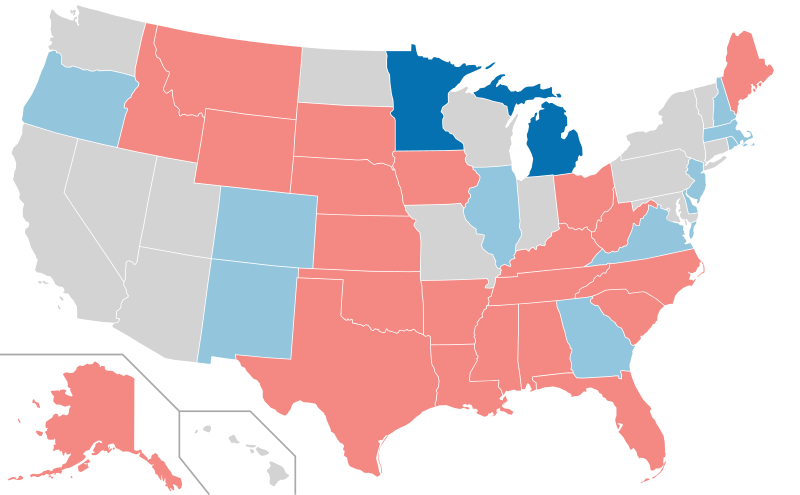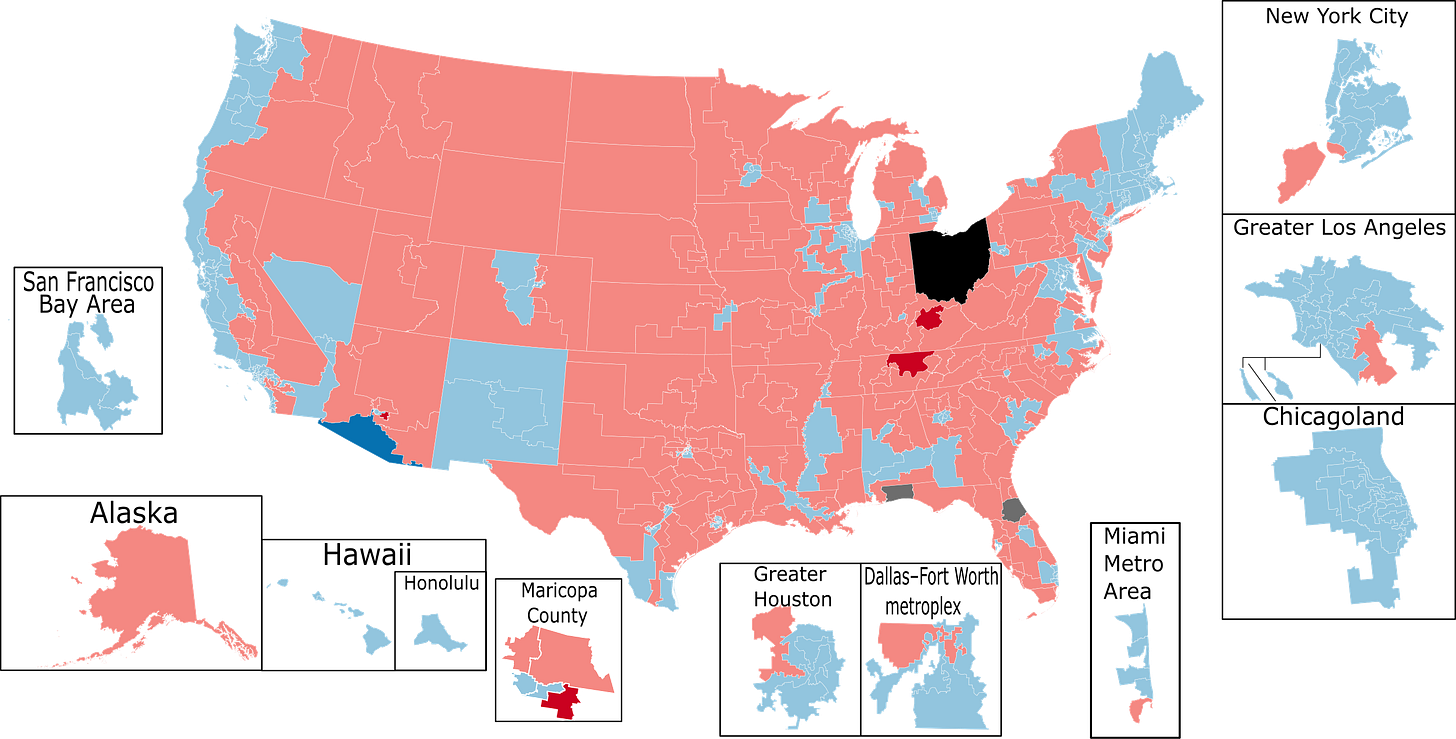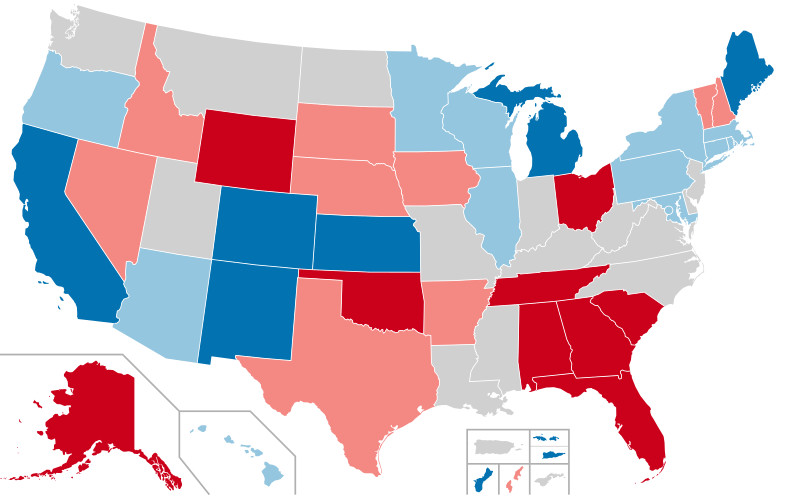(Updated) Free Subscribers Edition-Breaking Down the 2026 Midterm Maps:
What it will take for Democrats in each respect to win.
Apologies in advance for the redundant inbox notifications. After careful consideration, I have decided to make this post accessible for everyone to see (the vast majority of whom are free subscribers). Feel free to check out the website pages for such and any other future updates.
Feel free to check the past Biden Era archives and follow the editions to come in the Trump Era on Substack, Medium, and LinkedIn (First Come, First Serve!).
Another midterm cycle is coming upon us soon enough.
We don’t know what will happen in the next 600 or so days leading up to it, so it is hard to hypothesize what the outcomes will be. I instead hope to formulate what conventional wisdom tells us and how Democrats have to work for their wins across the board, especially if there is a backlash of some kind to Trump’s Project 2025 agenda despite the GOP base holding for 47.
Remember, Trump’s so-called “electoral mandate” was in part from him distancing himself from the very unpopular Project 2025 agenda. His denials and self-proclaimed ignorance of the contents of 2025 were numerous and memorable.
US Senate:
For the US Senate, there are two announced retirements (in Michigan and Minnesota). I have no doubt in a good midterm cycle for the opposition party that potential candidates like Garlin Gilchrist, Dana Nessel, Peggy Flanagan, or Keith Ellison will hold those seats if any of them were to run for Senate, as would other names in the mix. A 2018 midterm-like landscape would be more than good enough to help hold those two Democratic seats (and Jon Ossoff’s in Georgia).
Keep an eye on potential retirements like those of Illinois’s Dick Durbin (Congressmembers Lauren Underwood and Jesus Chuy Garcia both ideal successors to Durbin), Colorado’s John Hickenlooper, New Hampshire’s Jeanne Shaheen, and even Massachusett’s Ed Markey, who is turning 79 this year but previously intended to seek reelection, with the gerontocratic concerns front and center with Democrats today.
The pickups are few conventionally. It is likely Democrats need to compete for Maine (Susan Collins) and North Carolina (Thom Tillis) to even get near a Senate majority, especially with ideal candidates who appeal to rural, working class voters like Chloe Maxmin and Roy Cooper, if they were to run.
Taking the Senate will be very hard if political calcification patterns continue, where presidential preferences translate to down ballot results. That is why DNC reforms, like those we have discussed here in the Howard Dean stories, are so crucial. Without new approaches and ideas, and better branding, Democrats can’t retake the Senate, and they have a mentality assuming such right now.
Democrats must remake the map to flip the Senate. Find places to take advantage of another suburban backlash, and/or most likely courting working class voters and rural voters into the fold.
Take Iowa and Ohio as archetypes of the latter. They both hold a bunch of Obama-Trump pivot counties (especially in Eastern Iowa and Northeastern Ohio if you look at the CNN & Wikipedia election maps), blue-collar Democrats in rural counties and industrial areas all across the states who found appeal in Trump’s political rhetoric and campaign promises with similar beliefs on free trade and cultural issues. And they do believe Democrats forgot them with their pro-corporate turn in the 1990s.
While a durable party infrastructure is very important, so is candidate quality. In a good midterm cycle, both keys could give prominent Democrats like Iowa State Auditor Rob Sand and Ohio Congressman Tim Ryan, or Senator Sherrod Brown, real fighting chances.
A combination of both voter backlashes is likely needed in Texas and Florida for any hope of victory. While we know suburban backlash is real in both states, they can be canceled out by voting pattern shifts among working class Hispanic and black voters, especially in the Rio Grande Valley and South Florida.
While more uphill, Cristina Tzintzun Ramirez and Jose Javier Rodriguez would offer compelling choices and profiles where controversial Trump-like candidates and DNC party organization build-up can boost their chances.
It is not impossible to win Ohio and Iowa, or Texas and Florida to a lesser extent (all states Trump won by 12-14 points). But considering partisan polarization, they will be uphill battles no matter what, win or lose.
Of course, many people thought Democrats could not retake the Senate in 2006, even up to Election Day, until they did. A combination of strong candidates, 50-state party organizing, robust election litigation teams, and regular rural voter engagement secured an unlikely majority after having only 45 seats the previous session (currently, Democrats have 47 Senate seats to Republicans’ 53).
And there could be other targets on the map in an ideal midterm environment. Kansas Governor Laura Kelly, or Attorney Chris Mann, would offer some hope in a state ever slightly trending towards Democrats.
Former Kentucky State Auditor Adam Edelen offers a unique populist-style campaign with his own track record in public office and as a renewable energy champion in coal-producing areas. With McConnell most likely retiring, that could be another sleeper race, if Edelen or Lt. Governor Jacqueline Coleman were to run there.
Alaska is not impossible either, especially if Congresswoman Mary Peltola, a rumored candidate for Senate, runs against incumbent Dan Sullivan. That could become really competitive in a great midterm environment.
And Montana could be on the radar of higher-hanging fruit, if a candidate in the mold of Brian Schweitzer or Jon Tester, someone younger ideally, is recruited.
Name recognition and campaign fundraising are big obstacles, and that would have to be considered for upstart challengers to beat the odds against longtime incumbents, especially without DNC party infrastructure.
US House
There are already a couple of retirements (including that of longtime Congressman Raul Grijalva and potential Arizona gubernatorial candidate Andy Biggs).
Electoral party calcification can also reduce the size of a House majority, but enhanced Howard Dean-style reforms can improve the party’s odds, even on such high expectations. The urban and suburban House seats out there are almost all held by Democrats (with certain exceptions like NY-17, NY-01, PA-01, NE-02, NJ-07, CA-40, CA-41, CA-22, VA-02, CO-08, AZ-06, & AZ-01).
However, a larger House majority would require notably improved performances among working class voters in de-industrial communities and rural areas such as PA-07, PA-08, PA-10, PA-14, PA-16, OH-10, OH-15, OH-07, OH-06, OH-14, IN-02, IN-08, IN-09, IN-05, MI-07, MI-04, MI-10, MO-02, MO-06, IA-01, IA-02, IA-03, WI-01, WI-03, WI-07, MN-01, MN-08, MN-07, NJ-02, NY-21, VA-01, NC-11, SC-01, GA-01, FL-27, FL-28, FL-14, TX-15, TX-23, CO-03, AZ-02, MT-01, and CA-03. Many of these congressional districts are the kinds Obama won or ran very competitively with Republicans in 2008 and/or 2012, as did presidential candidates in the mold of Al Gore or John Kerry.
In a really good cycle, like 2018, many of these seats are winnable. In a 2022-like cycle, Democrats may fall short of those expectations, or the majority outright.
Getting a majority also means Democrats have to defend incumbents in Trump Country (13 or 14 members to be exact). That includes vulnerable House incumbents such as Marcy Kaptur, Marie Gluesenkamp Perez, and Jared Golden, and not counting whatever comes out of the unusual mid-decade Ohio redistricting session later this year, or the ongoing litigation with the Baton Rouge-based LA-06 district.
Governors
Finally, for now, are the governorships. Democrats are more like playing defense on the map, at least for now.
Whether there are term limits or not in the states, the fact is Democrats have a lot of ground to cover, at least based on the 2024 election results. If the midterm environment is much better, that’s another story.
Consider 5 of the 7 quintessential battleground states are held by the Democrats, 4 of which are up this cycle (especially Michigan). Additionally, Democrats have to defend seats in states trending toward Republicans like Minnesota, New Mexico, Maine, and New York, plus Kansas.
They, however, do have a few pickup opportunities, most notably Nevada, Georgia, and New Hampshire. Vermont may be a possibility if Phil Scott retires.
It is not impossible states such as Ohio and Iowa come online, though the fact is Democrats have a lot more on the map to defend than Republicans do.
If Democrats can remake the political map, maybe they will have more pickup opportunities across the contests. If not, they will be defending a lot more territory heading into 2026. Either way, they should anticipate high midterm voter turnout.
If Trump remains popular, a big IF, that will bode well for Republicans.
The 2025 New Jersey and Virginia elections nonetheless will be the first such test of whether Democrats can break through Trump constituencies for 2026.
And for comical reasons, let me do my initial 2026 projection guesses here as of today:
Senate: 51-49 GOP
House: 227-208 DEM







